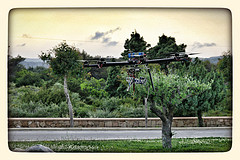
Theo Jansen‘s world-famous ‘strandbeests’ [strandbeest = beach beast/animal — Dutch plural would be ‘strandbeesten’] have been around since 1990 when he started experimenting with mechanical engineering, building skeletons from plastic pipes that use the wind power to move ‘magically’ all on their own.
“The mini-strandbeest uses the same mechanism designed specifically by the artist for the project and like its forebear comes with a fan at one end that catches the wind, propelling the legs to move in a cyclical fashion. Built from 120 parts that snap together to form 12 jointed legs, a spinelike crankshaft, and a wind turbine, it takes about 90 minutes to build.”
Where can you buy them? Give Google a whirl using ‘mini-strandbeest DIY’ and quite a few results will pop up that seem quite affordable.
Watch how to make your own mini-strandbeest:
(Link and photo: designboom.com)







![[scan]](https://www.24oranges.nl/wp-content/uploads/2008/08/ultra-portable-150x150.jpg)